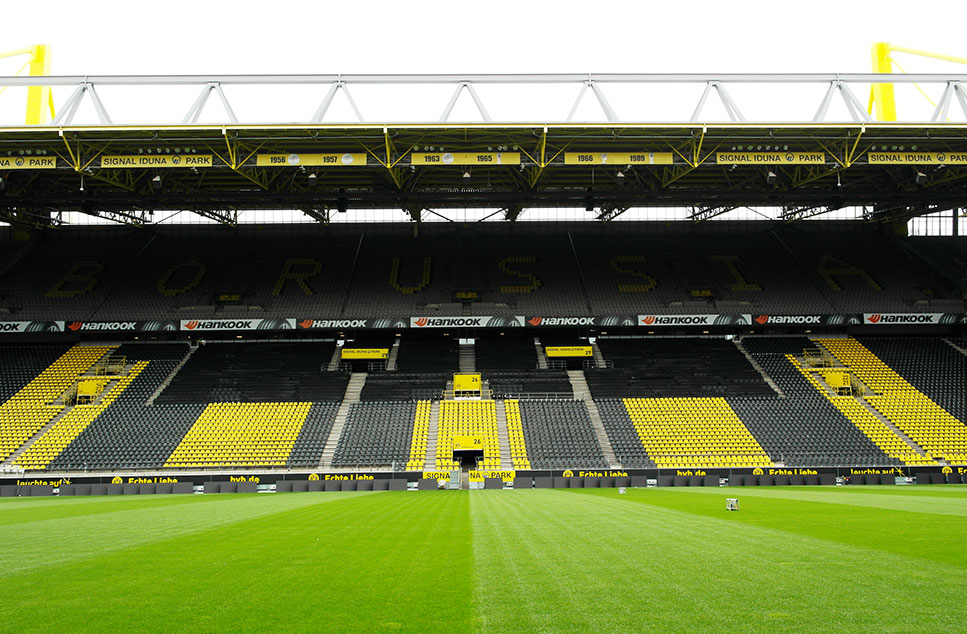
Affordable blue category 4 is close to the action in the corners, with yellow 5 and green 6 behind. There are six main categories, excluding the sold-out standing Stehplätze behind the goal. You pick up tickets two hours before kick-off at the Hinterlegunskasse Nord on Strobelallee. Online ticket sales are dealt with by Eventim. Exit left out of the train for Ausgang Süd, before walking past Rosenterrassen for Strobelallee. On match days, the nearby stop at Signal Iduna Park operates on the U45 line, which otherwise runs as far Westfalenhallen, ten minutes’ walk from the stadium ahead of you to your right. The stadium is south of town, a 25-minute walk from the centre down Hohe Straße. While the largest average attendance in Europe fills the famed Südtribune at one end, most of the Nord at the other, and West and Ost on the sidelines, away fans are allocated an upper corner of the Nordtribune.

Thereafter, the stadium reverted back to its sponsored name of the Signal Iduna Park and capacity has slowly been creeping up, for domestic fixtures at least, ever since. Capacity fell back to an all-seated 65,000 – not that many would have been calmly sitting down during Germany’s epic semi-final with Italy, decided on two last-gasp goals from the visitors. For the 2006 World Cup, architects Engels and Partners unveiled €35ml worth of improvements, including five video screens. Shortly afterwards, always packed the rafters, the Westfalenstadion increased capacity to 68,600, then 83,000. With a team of returnees from Serie A – Matthias Sammer, Andreas Moller, Jurgen Kohler – Dortmund won the Champions League in 1997. After a lengthy dip in form, Borussia bounced back under Ottmar Hitzfeld to hit the top again in the 1990s. A football-specific stadium, right next door to the Rote Erde, was duly built: the Westfalenstadion.įirst staging the Revierderby with Schalke04 that April, this 54,000-capacity ground hosted four games for the finals, including the de facto semi between Holland and Brazil.īy then, Borussia were wallowing in the second flight. In 1971, Cologne turned down the chance of being a venue for 1974 World Cup, so the opportunity, and the funds, passed to Dortmund. Holding a capacity 42,000, the Rote Erde was heaving on big nights, such as during the European Cup run of 1963-64 and high-profile games against Benfica, Dukla Prague and Internazionale.Ī new stadium had long been proposed. With Siggi Held, Reinhard ‘Stan’ Libuda and Lothar Emmerich, Borussia won league, cup and the Cup Winners’ Cup of 1966, the first German club to win a European trophy. But BVB really took off in the mid-1960s. First came the team spearheaded by the Three Alfredos – in actual fact, three Alfreds, Preißler, Kelbassa and Niepieklo. Relocating to the Rote Erde south of the city centre, Borussia began to enjoy considerable post-war success. Previously, the club had been based at the Weisse Wiese on Wambeler Strasse, near Borsigplatz, BVB’s spiritual home north-east of town where you’ll still find bars decked out in yellow-and-black memorabilia. Opened as part of the Volkspark communal sports complex in 1926, the ‘Red Earth’ hosted mainly athletics meets before Borussia moved there in 1937. Behind it, still operating as the club’s reserve-team ground, is the BVB’s previous home of the Rote Erde.

Still commonly known as the Westfalenstadion, the arena is the biggest football stadium in Germany, no mean feat.
#Signal iduna park full#
This is where you find, and hear, the Yellow Wall, famously comprised of 25,000 gathered on football’s largest remaining standing terrace, the Südtribune of the 81,645-capacity Signal Iduna Park.Īnd the day of the Revierderby with local rivals Schalke 04 is when you hear the Wall in full wail. Set in Germany’s industrial Ruhrgebiet, with a compact and pedestrianised centre, Dortmund is very much a one-club city – and that one club, Borussia, attracts the highest average attendance in the world game. See Signal Iduna Park: Borussia Dortmund v Schalke 04, Bundesliga, Sunday Nov 8/1530 CET-1430 UK timeĭortmund is built on beer and football. Regularly refreshed with new destinations and travelogues, Libero is a one-click treasure trove of football trip tips, tales and trivia.

Dortmund is one of 150 soccer cities featured in Libero, the digital travel guide for football fans.


 0 kommentar(er)
0 kommentar(er)
